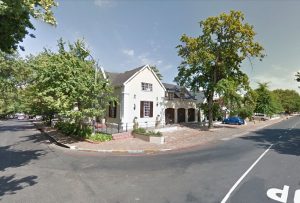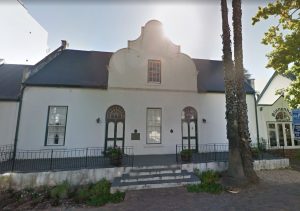Stellenbosch had 2 big fires, the first in 1710 and the second in 1803. With the devastating fire of 1803, 42 buildings burned down, about a third of the town at that stage.
These two disasters (as well as gale force winds that occasionally damaged the buildings) are some of the reasons why all the historic buildings in the town center weren't preserved. Plein Street and Van Riebeeck street were especially affected.
Here are some interesting facts about fire and fire fighting in Stellenbosch's early history:


Fire was always a major threat to Stellenbosch as most of the buildings had thatched roofs. Initially they used a kind of straw ('rogstrooi') as it was cheaper than flat roofs (which was made of stone). The straw was later replaced with reeds to form today's thached roofs. Furniture, ceilings and floors were all made of indigenous wood.

Stellenbosch's first 'fire station' was at the jail/gaol at the old Drostdy (the theological seminary today). When the jail later needed the space the 'fire department' was moved to the market building in Mark Street - today the Kruithuis.

In 1736 notices were distributed across town to ban people from smoking in the streets. People weren't allowed to discard burning coals from their pipe or move around with any burning object in the street.

In the case of both big fires, the villagers pleaded help from the authorities to rebuild their lives (the Kompanjie and Political Council). The victims of the second fire were only eligible for government loans if they promised not to build thatched roofs again.

One of the greatest necessities of fire victims was wood, as it was expensive and the chopping of trees forbidden in parts of Stellenbosch. The town pleaded with authorities to send a ship from Plettenberg Bay or Mossel Bay with enough wood.

Before the time of old fire extinguisher (pictured above) the firemen usually used buckets made of leather. To house the new machine a small "fire house" was built on the corner of Dorp Street and Drostdy Street. Two firemen and four assistants were appointed, one whose name was Lambert Fick.


When the town's only church building burned down in 1710, the town was without a church building for about 12 years. During this time the congregation gathered in Welgevallen wine cellar which is now part of the Morkel house (pictured below). Read more about this time in the church's history on their website.

Remember, Stellenbosch is a unique town with a rich history! Help us protect our heritage! Take your kids to see the old fire extinguisher at the Stellenbosch Museum or support projects and innovations fighting fires in Stellenbosch - read about one such innovation here.

Artikel: Y Coetsee 2017
Bronne/Sources: Stellenbosch drie Eeue (1979)